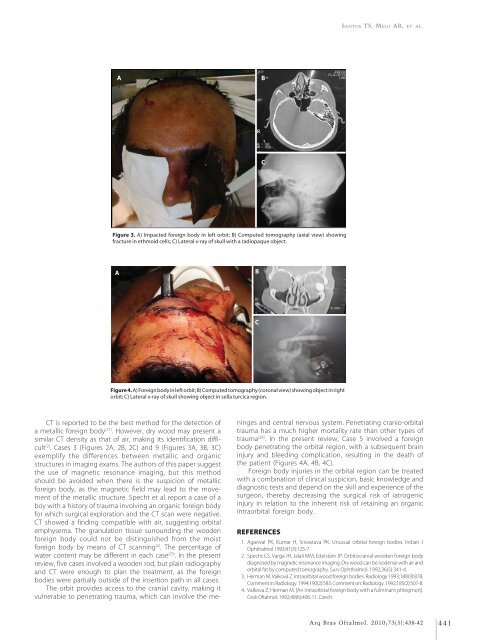Monovision and cataract surgery Visual field and OCT correlation ...
Monovision and cataract surgery Visual field and OCT correlation ...
Monovision and cataract surgery Visual field and OCT correlation ...
Create successful ePaper yourself
Turn your PDF publications into a flip-book with our unique Google optimized e-Paper software.
SANTOS TS, MELO AR, ET AL.<br />
A<br />
B<br />
C<br />
Figure 3. A) Impacted foreign body in left orbit; B) Computed tomography (axial view) showing<br />
fracture in ethmoid cells; C) Lateral x-ray of skull with a radiopaque object.<br />
A<br />
B<br />
C<br />
Figure 4. A) Foreign body in left orbit; B) Computed tomography (coronal view) showing object in right<br />
orbit; C) Lateral x-ray of skull showing object in sella turcica region.<br />
CT is reported to be the best method for the detection of<br />
a metallic foreign body (21) . However, dry wood may present a<br />
similar CT density as that of air, making its identification difficult<br />
(2) . Cases 3 (Figures 2A, 2B, 2C) <strong>and</strong> 9 (Figures 3A, 3B, 3C)<br />
exemplify the differences between metallic <strong>and</strong> organic<br />
structures in imaging exams. The authors of this paper suggest<br />
the use of magnetic resonance imaging, but this method<br />
should be avoided when there is the suspicion of metallic<br />
foreign body, as the magnetic <strong>field</strong> may lead to the movement<br />
of the metallic structure. Specht et al. report a case of a<br />
boy with a history of trauma involving an organic foreign body<br />
for which surgical exploration <strong>and</strong> the CT scan were negative.<br />
CT showed a finding compatible with air, suggesting orbital<br />
emphysema. The granulation tissue surrounding the wooden<br />
foreign body could not be distinguished from the moist<br />
foreign body by means of CT scanning (2) . The percentage of<br />
water content may be different in each case (25) . In the present<br />
review, five cases involved a wooden rod, but plain radiography<br />
<strong>and</strong> CT were enough to plan the treatment, as the foreign<br />
bodies were partially outside of the insertion path in all cases.<br />
The orbit provides access to the cranial cavity, making it<br />
vulnerable to penetrating trauma, which can involve the meninges<br />
<strong>and</strong> central nervous system. Penetrating cranio-orbital<br />
trauma has a much higher mortality rate than other types of<br />
trauma (26) . In the present review, Case 5 involved a foreign<br />
body penetrating the orbital region, with a subsequent brain<br />
injury <strong>and</strong> bleeding complication, resulting in the death of<br />
the patient (Figures 4A, 4B, 4C).<br />
Foreign body injuries in the orbital region can be treated<br />
with a combination of clinical suspicion, basic knowledge <strong>and</strong><br />
diagnostic tests <strong>and</strong> depend on the skill <strong>and</strong> experience of the<br />
surgeon, thereby decreasing the surgical risk of iatrogenic<br />
injury in relation to the inherent risk of retaining an organic<br />
intraorbital foreign body.<br />
REFERENCES<br />
1. Agarwal PK, Kumar H, Srivastava PK. Unusual orbital foreign bodies. Indian J<br />
Ophthalmol 1993;41(3):125-7.<br />
2. Specht CS, Varga JH, Jalali MM, Edelstein JP. Orbitocranial wooden foreign body<br />
diagnosed by magnetic resonance imaging. Dry wood can be isodense with air <strong>and</strong><br />
orbital fat by computed tomography. Surv Ophthalmol. 1992;36(5):341-4.<br />
3. Herman M, Vaiková Z. Intraorbital wood foreign bodies. Radiology 1993;188(3):878.<br />
Comment in: Radiology. 1994;190(2):583. Comment on: Radiology. 1992;185(2):507-8.<br />
4. Valkova Z, Herman M. [An intraorbital foreign body with a fulminant phlegmon].<br />
Cesk Oftalmol. 1992;48(6):406-11. Czech.<br />
Arq Bras Oftalmol. 2010;73(5):438-42 441

















